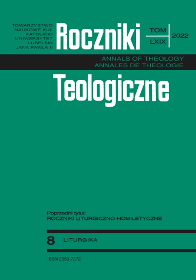Ordained and Baptized Ministries Through the Lens of Liturgical Singing
Abstract
After decades of ecumenical dialogue, the understanding of the relationship between the ministries of the baptized and the ordained continues to be a dividing matter between churches and traditions. This paper suggests that liturgical singing, in which individual and communal song with specific roles become a single and unified liturgical action, offers a model aiming to contribute to the bridging of this persistent divide.
Liturgical theologians have in recent times begun to analyse the fabric of liturgical artistic activities and the complex relationship between the different ministries involved. Here, the dialogue with neurobiological research has helped theology to better understand the roles and functions of the single voice and the group of voices woven into the liturgical texture. This paper proposes that a better understanding of the functioning and the aesthetic nature of liturgical singing puts a new hermeutical tool at the service of the ecumenical dialogue on ministry.
References
Bonaccorso, Giorgio. Critica della ragione impura. Per un confronto tra teologia e scienza. Assisi: Citadella Editrice, 2016.
Bonaccorso, Giorgio. “Fede e neuroscienze: Il ruolo del corpo.” AlzogliOcchiversoilCielo. Accessed March 2, 2022. https://www.alzogliocchiversoilcielo.com/2019/06/fede-e-neuroscienze-il-ruolo-del-corpo.html.
Bonaccorso, Giorgio. Il corpo di Dio. Vita e senso della vita. Assisi: Citadella Editrice, 2006.
Bonaccorso, Giorgio. L’estetica del rito. Sentire Dio nell’arte. Cinisello Balsamo: Edizioni San Paolo, 2013.
Fagerberg, David. Theologia Prima. What is Liturgical Theology? Chicago: Hillenbrand Books, 2004.
Grillo, Andrea. Einführung in die liturgische Theologie. Zur Theorie des Gottesdienstes und der christlichen Sakramente. Göttingen: Vandenhoeck & Ruprecht, 2006.
Haspelmath-Finatti, Dorothea. Theologia Prima – Liturgische Theologie für den evangelischen Gottesdienst. Göttingen: Vandenhoeck & Ruprecht, 2014.
Kirschner, Sebastian, and Michael Tomasello. “Joint Music Making Promotes Prosocial Behavior in 4-Year-Old Children.” Evolution and Human Behavior 31 (2010): 354–364.
Körner, Felix, and Wolfgang Thönisson, eds. Vermitteltes Heil. Luther und die Sakramente. Paderborn and Leipzig: Bonifatius and Evangelische Verlagsanstalt, 2018.
Lathrop, Gordon. Holy People. A Liturgical Ecclesiology. Minneapolis, MN: Fortress Press, 2009.
Lathrop, Gordon. Holy Things. A Liturgical Theology. Minneapolis, MN: Fortress Press, 1998.
Lathrop, Gordon. The Four Gospels on Sunday. The New Testament and the Reform of Christian Worship. Minneapolis, MN: Fortress Press, 2011.
Lavretsky, Helen et al. “A Pilot Study of Yogic Meditation for Family Dementia Caregivers with Depressive Symptoms: Effects on Mental Health, Cognition, and Telomerase Activity.” International Journal of Geriatric Psychiatry 28 (2013): 57–65.
Mühling, Markus. Resonances: Neurobiology, Evolution and Theology. Evolutionary Niche Construction. The Ecological Brain und Relational-Narrative Theology. Göttingen: Vandenhoeck & Ruprecht, 2014.
Nüssel, Friederike. “Amt und Ordination bei Martin Luther und in der lutherischen Dogmatik.” In Vermitteltes Heil, Luther und die Sakramente, edited by Felix Körner and Wolfgang Thönisson, 143–161. Paderborn and Leipzig: Bonifatius and Evangelische Verlagsanstalt, 2018.
Vetö, Etienne. “Ministry and Priesthood. The influence of Luther on the Roman Catholic understanding of ministry and its ecumenical stake.” In Vermitteltes Heil, Luther und die Sakramente, edited by Felix Körner and Wolfgang Thönisson, 162-176. Paderborn and Leipzig: Bonifatius and Evangelische Verlagsanstalt, 2018.
Copyright (c) 2022 Roczniki Teologiczne

This work is licensed under a Creative Commons Attribution-NonCommercial-NoDerivatives 4.0 International License.





